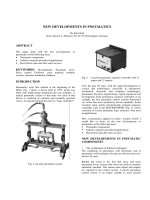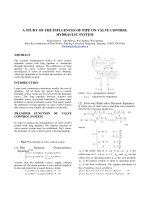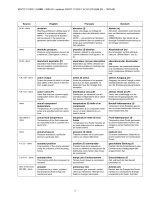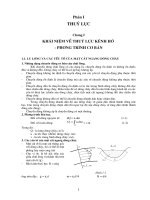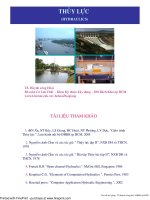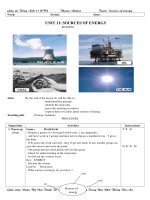Bài giảng thủy lực - Tiếng anh - P3
Bạn đang xem bản rút gọn của tài liệu. Xem và tải ngay bản đầy đủ của tài liệu tại đây (40.02 KB, 4 trang )
The Project Sponsored by ROC, SEM
A RESEARCH AND APPLICATION ON A NEW FNN CONTROL
STRATEGIES
*
Wang Sun’an and Du Haifeng
Xi’an Jiaotong University, 710049, Xi’an, P.R. China
ABSTRACT
As the precise model of most practical mechatronics
system cannot be obtained, the practice of typical
control method is limited. Accordingly, numerous AI
(Artificial Intelligence) control methods have been used
widely. Fuzzy control and Neural Network control have
been an important point in the developing process of the
field. However, shortcomings exist in each of these
methods. For example, the fuzzy control is unable to
learn, and the physical meanings of learning result of
the Neural Network control are not clear. Combining the
strong points of above two methods, a new control
method of FNN (Fuzzy Neural Networks) is explored in
this paper. Additionally, a problem concerning the
traditional network learning is discussed and a solution
to such a problem is obtained subsequently. The new
control strategy does not depend on the classical model
and the algorithm is simple. The results of the
experiments applying the new strategies are discussed.
Through different researches on control system, which
model is unacquainted, the reasonableness, effectiveness
and applying universality of the new control strategies is
proved.
INTRODUCTION
The mechatronics system becomes more and more
complicated. According to the Incompatibility Principle
[1], the higher complicacy of the system is, the lower
ability to describe becomes. So the typical control
methods based on the precise model cannot meet the
need. AI offers new strategies for the mechatronics
control system.
Since the AI Project was launched at MIT in 1957, it
has achieved great success in many fields. It attracts
more and more attention to AI and many AI methods
have been put forward
[2]. Fuzzy and NN (Neural
Networks) are important aspects in AI, simulating
different functions of the human brain. The former
simulates the macroscopical functions, such as
syllogisms, but the latter simulates the associatron,
classification, memory by way of imitating the
microcosmic structure. But the Fuzzy cannot learn and
the NN cannot deduce. In addition, the Fuzzy can be
understood and the learning results of the NN cannot
[3]. The new AI method, FNN , which integrated the
good qualities of the two methods, has been the hotspot
in AI fields.
Firstly, this paper will discuss a new object function of
FNN learning and a problem in NN control system.
Then a new FNN control structure will be put forward
based on them. Finally, some conclusions will be
acquired, supported by related experiments.
THE OBJECT FUNCTION
Object function is very important for the control system.
∫e
2
dt is usually taken as the Object function in time
fields. The smaller the area, like figure 1, which
surrounded by the phase track in the phase space is, the
better performance of the system is. So the integrated
object function can be defined as
deedteJ
∫
+
∫
=
&
βδ
2
(1)
where e is the error between the sysytem’s real output
and the reference input. e
&
is the differential coefficient
of e . ∫e
2
dt is the general object function,
∫
dee
&
is the
area. δ and β are the weighted coefficients.
Fig. 1 A example of phase space
On second thoughts
( )
dtedt
dt
de
dt
de
de
dt
de
dee
2
&&
=∗∗==
(2)
dtedee
∫ ∫
=
2
&&
(3)
The area surounded by the phase track is the integration
of the error’s differential coefficient. So the error and its
differential coefficient are synthetically considered in
the new object.
A PROBLEM IN NN CONTROL
NN control just applies the NN’s approximating ability.
A typical NN control system likes figure2.
System
f(U)
u
e
e
&
+
-
W
r
y
a
Fig. 2 The typical structure of NN
Where y is the real output, r is the reference input,
u is the NN’s output, and e is the system error. The
object of the control is made y=r, namely e becomes 0.
The learning method adopted is usually Gradient
Search. Obviously, the error is the main parameter in
this method.
In theory, the error which is needed by the NN
learning is e’, defined as
o
uue −= (4)
Where u
o
is the NN’s desired output. u
o
can be
obtained:
)(
1
rfu
o
−
= (5)
So the general object function can be defined as:
21
))(( rfuJ
e
−
∗
−=
(6)
Then
w
rf
rfu
w
J
e
∂
∂
−−=
∂
∂
−
−
∗
)(
))((
1
1
(7)
Because the precise model of the system can not be
obtained, even though the precise model is obtained,
most practical mechatonics system is very complex.
Therefore, the equations cannot be solved. So u
o
is not
known. Practically, y usually is used to replace u
o
, as a
result, the object function is defined as
2
)( yrJ
e
−=
(8)
So
w
y
yr
w
J
e
∂
∂
−−=
∂
∂
)(
(9)
Generally the following equation is not true.
w
rf
rfu
w
y
yr
∂
∂
−=
∂
∂
−
−
−
)(
))(()(
1
1
(10)
In fact, the signs are different from each other between
these at the two sides of the “=”. So the NN can not
approach the desired value, even the NN’s astringency
can not be guaranteed.
THE NEW CONTROL STRUCTURE
Based on the above discussion, a new control structure
of FNN can be put forward. It looks like figure 3.
Where the network NN1 is FNN network and NN2 is
the RBF network. W is the weight of NN1 and W’ is the
weight of NN2. NN1 is employed to obtain the control
output u. NN2 is just as the system’s inverse model, it is
used to acquire the u
o
, u’s desired output.
System
f(u)
u
e
e
&
+
_
W
r y
a
W'
a'
NN1
NN2
the learning
algorithm
u1
+
_
adjust
adjust
e
e
&
e
u
Fig. 3 The structure of the new FNN
There are lots of types of FNN, but generally they can
be classified two kinds. One is the NN which directly is
constructed by the Fuzzy’s rule,another is the NN which
is fuzzied from the unfuzzy NN.
In this paper, The FNN has two layers. Its topical
structure is achieved by the Fuzzy, and the fuzzy
learning ability becomes strong by taking advantage of
NN. The number of NN’s hidden layer’s nodes is just
the same with that of the fuzzy’s section and the accept
function of the nodes is corresponding to the
membership function of the Fuzzy section.
So define the object function again:
∫
+
∫
+
∫
= dtedtedteJ
u
2
22
γβδ
&
(12)
THE ALGORITHM
The new algorithm’s detail process is the following:
(1) Partition the fuzzy section according to e and e
&
(2) Initial the network
(3) Calculate
T
Wu *α=
where )......(
21 m
aaa £¬£¬=α is the accept
functionm is the number of the nodes
(4) Modify the weight W and W’
For the j th node, because:
dtegraddtegradJgrad
jjj
www
∫
+
∫
=
22
**
&
βδ
dtegrad
uw
j
∫
∗+
2
γ
(13)
dtegraddtegradJgrad
jjj
www
∫
+
∫
=
22
'''
**
&
βδ
dtegrad
u
w
j
∫
∗+
2
'
γ
(14)
)()(
T
Wfrufryre α−=−=−=
TT
u
WWuue αα −=−= ''1
T
j
TT
j
u
WW
w
e
αα
α
αα
)''(
2
−−=
∂
∂
T
j
TT
j
u
WW
w
e
''
'
)''(
'
2
αα
α
αα −=
∂
∂
jj
w
u
u
uf
ufr
w
e
∂
∂
∗
∂
∂
∗−−=
∂
∂ )(
)]([
2
αα
α
T
j
u
uf
ufr ∗
∂
∂
∗−−=
)(
)]([
u
uya
uyydtegrad
j
T
j
jRw
j
∂
∂
∗−−=
∫
)(
))((
2
αα
jjj
w
u
u
y
yr
w
y
yr
w
e
∂
∂
∗
∂
∂
∗−−=
∂
∂
∗−−=
∂
∂
&
&&
&
&&
&
][][
2
T
j
u
y
yr
αα
α
∗
∂
∂
∗−−=
&
&&
][
(15)
At the k th sample time:
)()1(
)()1()(
kuku
kyky
u
uf
−+
−+
≅
∂
∂
tkuku
kykyky
u
y
∆∗−+
−+∗−+
≅
∂
∂
)]()1([
)1()(2)1(
&
yr
t
yr
t
e
e
tt
&&&
−=
∆
−
=
∆
=
→∆→∆ 00
limlim
t
kyky
t
krkr
tt
∆
−+
−
∆
−+
=
→∆→∆
)()1(
lim
)()1(
lim
00
t∆
is the interval of sample time
))(1)((
''
)1()(2)1(
]
)()1()()1(
[
)]()([
)()1(
)()1(
*)()1(
'
kuku
t
kykyky
t
kyky
t
krkr
kykr
kuku
kyky
kwkw
T
j
T
j
jj
−∗
+
∆
−+∗−+
∗
∆
−+
−
∆
−+
∗
+−
∗
−+
−+
∗
∗+=+
αα
α
γ
β
δ
αα
α
η
))()(1(
''
'*)()1(
'
''
kukukwkw
T
j
jj
−+=+
αα
α
η
(16)
In this way, plenty of information is used in the learning
process for the NN1, and the damp of the system is
increase, which is useful for the stability of the system.
This point is proved in the experiments.
(5) If J supplies the demand, then stop, else go to (3).
Experiment
Some experiments using the above methods have been
done.
A three order system’s open-loop model is the
following:
sss
sG
322
2
10*31
1
*
975.4*975.4*041.0*2
975.4
)(
−
+++
=
Its step response likes figure 4. The result that is used
the new FNN control is also shown as figure 4.
Fig 4. The result of the physical emulational experiment
The result is obtained after six times learning.
Apparently it is better than that of PID and BP (The
result of PID and BP is not given). It is found in the
experiment that δ and β are very important for the result
Motor is the typical mechatronics system, but its precise
mathematics model cannot be obtained. Regulating the
motor’s speed is the normal work in the practice, and a
lot of methods in such an aspect have been brought
forward [4][5][6]. Figure 5 is the result of the
experiment about regulating the motor’s speed.
Fig. 5 The result of the experiment about motor
Fig 6. The result of the PID control
The result of the new FNN is obtained after three times
learning. Comparing the results of the experiments, the
strengths of the new FNN are outstanding. In addition,
PID’s parameter is confirmed hardly. The PID
optimized result shown in Fig.6, which is caused by
regulating again and again. According to the
experiments, the availability of the new FNN proposed
above is proved.
SUMMARY AND OUTLOOK
At first, a new object function based on the phase space
is defined, then a problem about NN’s learning is
discussed and a new FNN control Strategies is
proposed, at last two related experiments are practised.
Through the experiments, some results can be obtained:
(1) The new FNN is available.
(2) The new FNN does not need the precise
mathematics model of the system.
(3) The new object function is valid.
(4) The new FNN is good for overcoming the problem
in NN control.
It is very easy for the control rules to be mined from the
New FNN. There are some papers concerning this point
[7][8].
Finally, we would like to point out that both real time
ability of this new control and astringency are the
further work we will explore.
REFERENCE
[1] Sugeno M, K Tanaka, A fuzzy-logic-based
approach to qualitative modeling. IEEE Trans on Fuzzy
Systems, 1993, 1(1): 7-13.
[2] Daniel G.Bobrow, J.Michael Brady, Artificial
Intelligence 40 years later, Artificial Intelligence, 1998,
(103) 1∼4.
[3] Li Shaoyuan, Xi Yugeng, Chen Zengqiang, Yuan
Zhuzhi, The new progresses in Intelligent Control (I),
Control and Decision, 2000, 15(1): 1-5, (in Chinese).
[4] N.C. Sahoo, S.K. Panda, P.K. Dash, A current
modulation scheme for direct torquecontrol of switched
reluctance motor using fuzzy logic, Mechatronics ,
2000, 10 353370.
[5] Ma Hongtao, Wei Zeding, Zhai Cheng, The new
control system for alternating voltage adjusting and
practice, Journal of Hebei Academy of Sciences, 1997
(1): 12-14, (in Chinese).
[6] Xiang Jun, Li Shiwne, A PLL Motor-Speed control
system, Journal of South-West Jiaotong University,
1998, 33(6): 705-709, (in Chinese).
[7] Chen Ming, Wang Jing, Shen Li, Research on
Automatic Fuzzy Rule Acquisition Based on Genetic
Algorithms, Journal of Software, 2000,11(1): 85-90 (in
Chinese).
[8] Hou Yuanhui, Lu Yuchang, Shi Chunyi, Using two-
phase approach to extract knowledge from artificial
neural network, Journal of Qinhua University, 1998,
38(9): 96-99, (in Chinese).

